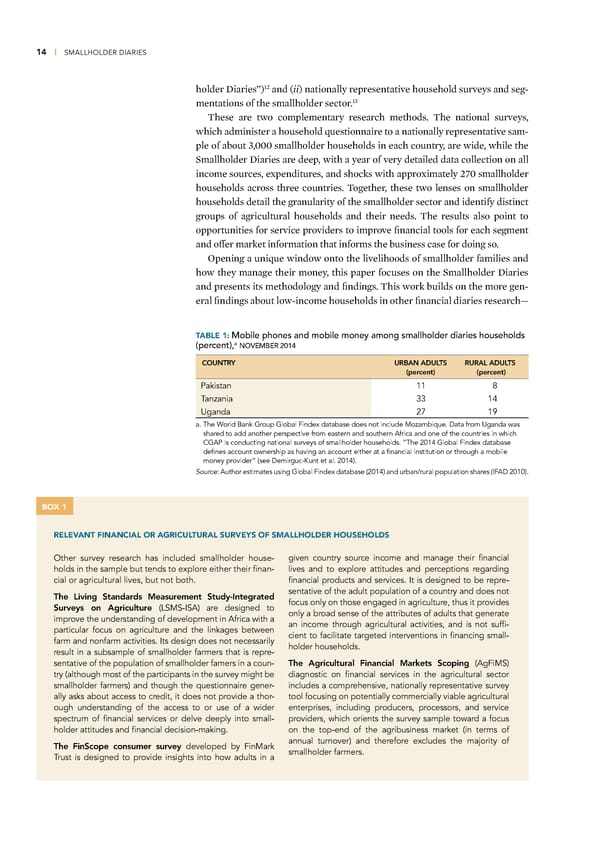14 | SMALLHOLDER DIARIES …‘ holder ‰iaries”) and (ii) nationally representative household surveys and seg- …Ÿ mentations of the smallholder sector Œhese are two complementary research methods Œhe national surveys, which administer a household uestionnaire to a nationally representative sam- ple of about Ÿ,’’’ smallholder households in each country, are wide, while the Smallholder ‰iaries are deep, with a year of very detailed data collection on all income sources, expenditures, and shocs with approximately ‘•’ smallholder households across three countries Œogether, these two lenses on smallholder households detail the granularity of the smallholder sector and identify distinct groups of agricultural households and their needs Œhe results also point to opportunities for service providers to improve financial tools for each segment and offer maret information that informs the business case for doing so ¦pening a uniue window onto the livelihoods of smallholder families and how they manage their money, this paper focuses on the Smallholder ‰iaries and presents its methodology and findings Œhis wor builds on the more gen- eral findings about low-income households in other financial diaries research— TABLE 1: Mobile phones and mobile money among smallholder diaries households (percent),a NOVEMBER 2014 COUNTRY URBAN ADULTS RURAL ADULTS (percent) (percent) Pakistan 11 8 Tanzania 33 14 Uganda 27 19 a. The World Bank Group Global Findex database does not include Mozambique. Data from Uganda was shared to add another perspective from eastern and southern Africa and one of the countries in which CGAP is conducting national surveys of smallholder households. “The 2014 Global Findex database defines account ownership as having an account either at a financial institution or through a mobile money provider” (see Demirguc-Kunt et al. 2014). Source: Author estimates using Global Findex database (2014) and urban/rural population shares (IFAD 2010). BOX 1 RELEVANT FINANCIAL OR AGRICULTURAL SURVEYS OF SMALLHOLDER HOUSEHOLDS Other survey research has included smallholder house- given country source income and manage their financial holds in the sample but tends to explore either their finan- lives and to explore attitudes and perceptions regarding cial or agricultural lives, but not both. financial products and services. It is designed to be repre- The Living Standards Measurement Study-Integrated sentative of the adult population of a country and does not Surveys on Agriculture (LSMS-ISA) are designed to focus only on those engaged in agriculture, thus it provides improve the understanding of development in Africa with a only a broad sense of the attributes of adults that generate particular focus on agriculture and the linkages between an income through agricultural activities, and is not suffi- farm and nonfarm activities. Its design does not necessarily cient to facilitate targeted interventions in financing small- result in a subsample of smallholder farmers that is repre- holder households. sentative of the population of smallholder famers in a coun- The Agricultural Financial Markets Scoping (AgFiMS) try (although most of the participants in the survey might be diagnostic on financial services in the agricultural sector smallholder farmers) and though the questionnaire gener- includes a comprehensive, nationally representative survey ally asks about access to credit, it does not provide a thor- tool focusing on potentially commercially viable agricultural ough understanding of the access to or use of a wider enterprises, including producers, processors, and service spectrum of financial services or delve deeply into small- providers, which orients the survey sample toward a focus holder attitudes and financial decision-making. on the top-end of the agribusiness market (in terms of The FinScope consumer survey developed by FinMark annual turnover) and therefore excludes the majority of Trust is designed to provide insights into how adults in a smallholder farmers.
 Financial Diaries with Smallholder Families Page 24 Page 26
Financial Diaries with Smallholder Families Page 24 Page 26